Easy Turkey Brine With Apple Cider Vinegar
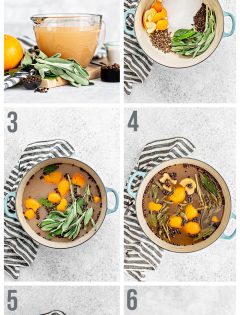
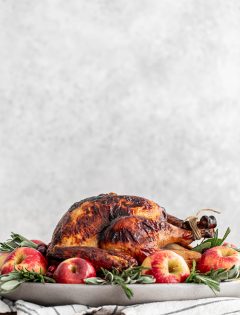
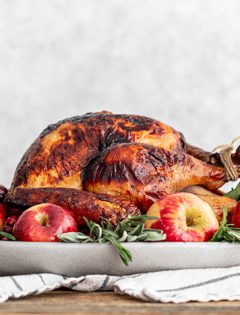
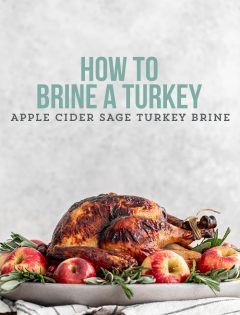
Jump to Recipe
This Apple Cider Sage Turkey Brine recipe results in a moist, flavorful turkey! In this post, I've also included a few rules you should know before attempting to brine a turkey.
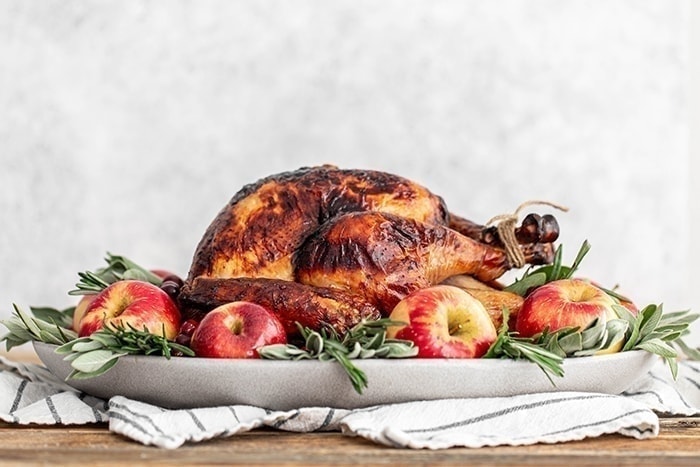
The Best Turkey Brine Recipe Ever
I have made a few different turkey brine recipes over the years. Last year I shared a recipe for Rosemary Beer Brine for a Smoked Turkey, and before that I mostly used a more basic recipe.
But, once you understand the process of brining, it is pretty easy to mix things up to create different flavor results. Because this will be our first Thanksgiving in Colorado and our first Thanksgiving with my sister living nearby, I thought: why not mix things up a little bit with a new turkey brine recipe for the big day?
We tested this apple cider turkey brine out in advance.We all agreed that it is definitely a winner.
Apple Cider Turkey Brine Ingredients
To make this easy turkey brine recipe, you'll need:
- Fresh apple cider
- Morton kosher salt
- Bay leaves
- Whole allspice berries
- Peppercorns
- Fresh sage leaves
- Orange peel
- Cold water
For the complete ingredient list and detailed instructions, scroll to the bottom of this post for the FREE printable recipe card.
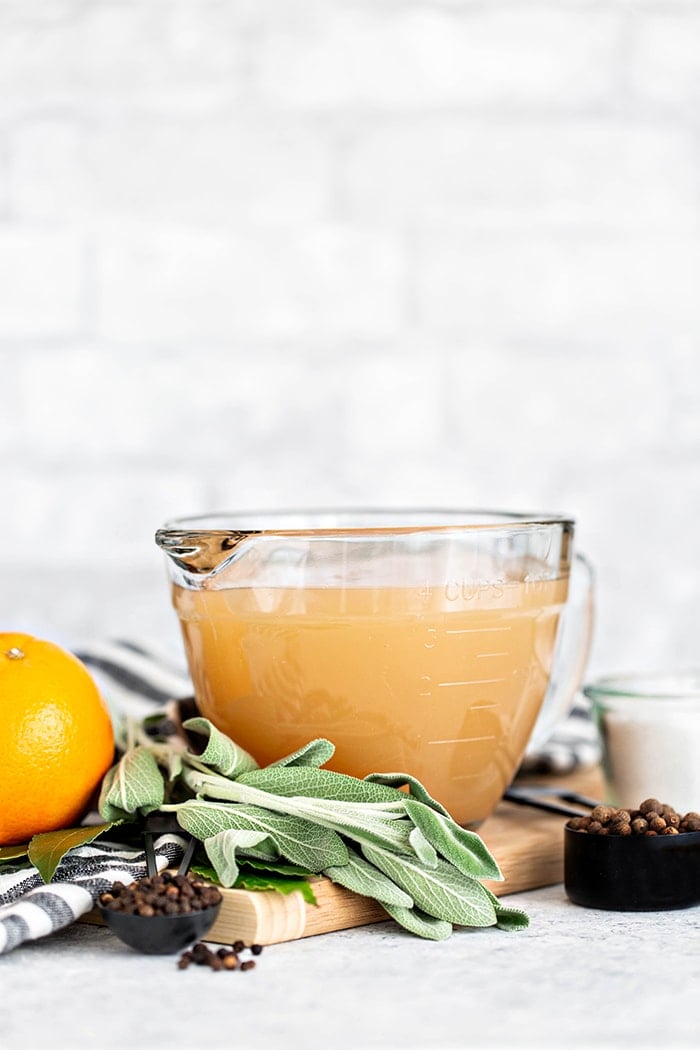
Click HERE to save this recipe for Apple Cider Sage Turkey Brine to Pinterest!
Ever wonder if a free turkey tastes better? Find out this holiday with aFREE TURKEY (all-natural, zero antibiotic) with your first order from ButcherBox.
How to Make a Turkey Brine
Making turkey brine couldn't be easier! Simply add all the ingredients but the water to a stockpot and bring the mixture to a boil. Then, turn the heat off and cool to room temperature before stirring in the cold water.
Once the apple cider turkey brine recipe has been prepped, you can move onto brining and roasting the turkey. Keep reading for detailed steps on how to do so.
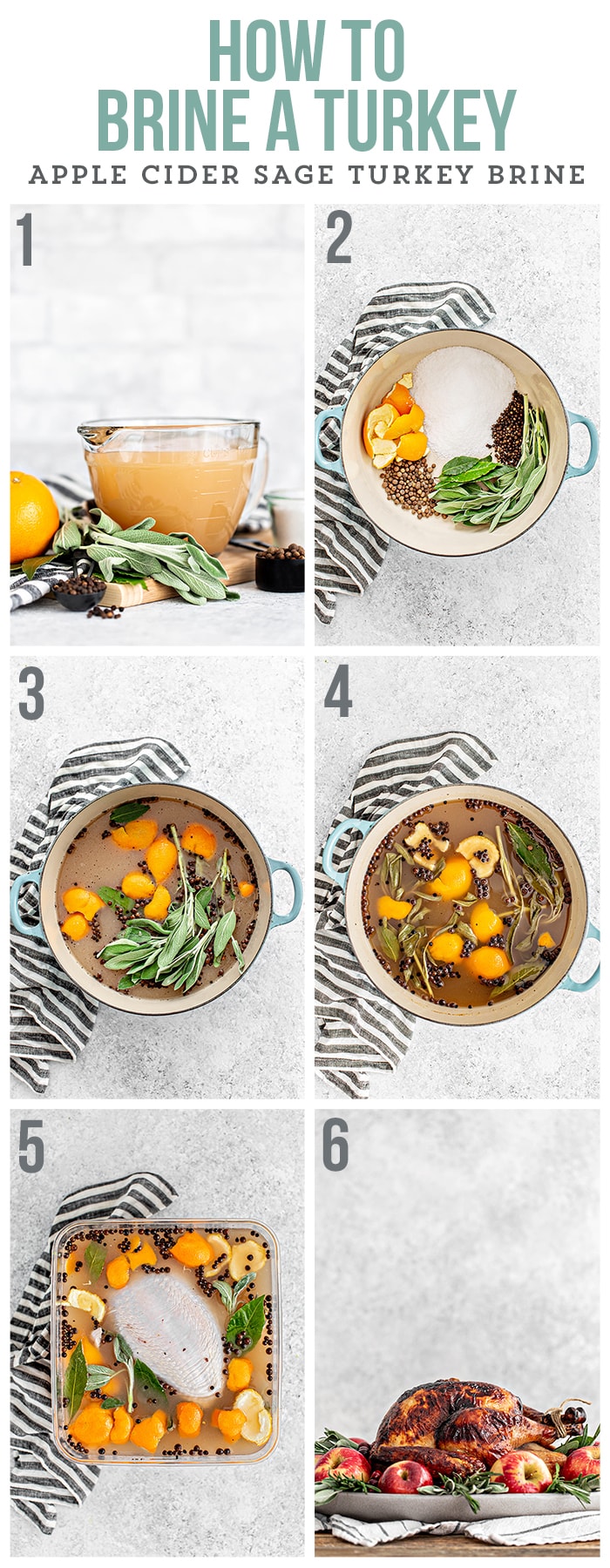
Click HERE to save this recipe for Apple Cider Sage Turkey Brine to Pinterest!
How Long Do You Brine a Turkey?
How long you will brine your turkey in this apple cider turkey brine largely depends on how big the piece of meat is. A simple boneless, skinless chicken breast or a couple of pork chops don't need more than an hour.
In contrast, a large 18+ pound turkey will need several hours or up to a full day to soak in the brine. Here is a quick run down recommended brining times according to my experience.
Brining Time Guide:
- Whole Turkey: 12-48 hours (depending on the turkey size)
- Turkey Breast: 3-6 hours
- Large Whole Chicken: 2-4 hours
- Chicken Breasts: 1 hour
What do you do if due to your schedule you need to brine the turkey earlier than 24 hours before roasting? I suggest brining it for the 12-48 hours you need.
Then, remove it from the brine and rinse it inside and out. Pat it dry with a paper towel. Then, store it in the fridge for up to an additional 24 hours until you are ready to roast. After that, you can proceed to roast as you normally would.
Does a Turkey Need to be Refrigerated While Brining?
Yes…and No. The turkey MUST be stored in an environment with a consistent temperature below 40 degrees F. The refrigerator is idea because it is a controlled environment.
Sometimes, though, your turkey might be rather large and the container that stores the turkey and the brine might be too large for your refrigerator, or simply just take up too much space that you don't have room for everything else.
If this is the case and you run out of room in your refrigerator, you can store your turkey as it brines in a large insulated cooler (the type meant to keep food very cold for several days) with extra ice and ice packs.
You would not want to add the ice to the brine because it would dilute the apple cider sage brine as it melts, so you would need to store the turkey with the brine in a sealed bag. Then, pack ice all around the turkey in the cooler. I like these extra large ziplock bags for storing brining turkeys in.
If you live somewhere with cold weather and know that the forecast will stay under 40 degrees for the high (but isn't so cold that you end up with a frozen turkey), then you can place the cooler outside or in a garage where it is colder than your house. Make sure to keep it out of the sun and away from animals.
Can You Brine a Frozen Turkey?
Many frozen turkeys come pre-brined in a plain salt water solution. Additionally, a turkey labeled as "kosher" will already be salted. Brining a turkey with this apple cider sage turkey brine in these situations would result in an incredibly salty turkey, which is not ideal.
If your turkey is NOT labeled kosher, but is frozen, you can add it to the brine while it is still partially frozen, as long as it will thaw the rest of the way within the proper bringing time so as not to be over-brined.
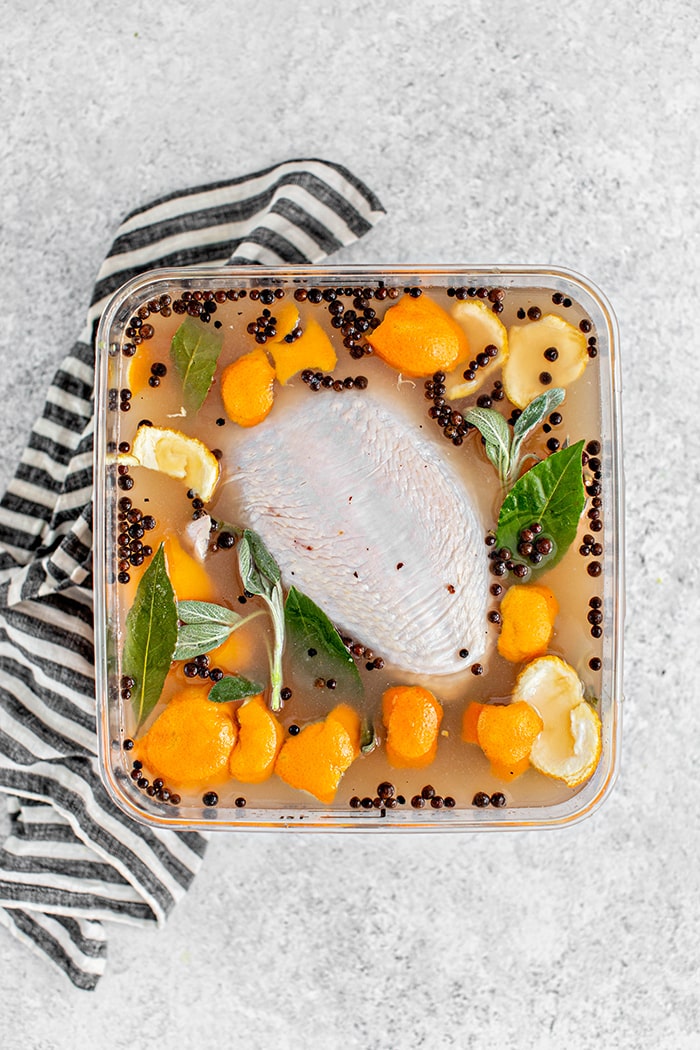
Click HERE to save this recipe for Apple Cider Sage Turkey Brine to Pinterest!
Tips for Making the Best Turkey Brine
Brining might sound complicated and lengthy, but once you get the hang of it the process is really not difficult. There are a few rules you should know about before you attempt brining a turkey.
If you are wondering how to roast a turkey, check out my Turkey Roasting Tips to learn more about the method that I like to use to roast my turkey as well as a few hints, tips, and tricks for a moist, flavorful turkey.
Keep the proportions of the recipe
If you need a larger or smaller amount of this apple cider turkey brine recipe, depending on the size of your bird, you will need adjust all of the ingredient amounts in the recipe. For example, all of the ingredients in this easy turkey brine would need to be doubled if you needed double the amount. Do not only double the liquid.
Once, we brined Cornish Game Hens in this apple cider turkey brine and it worked just fine. We just reduced the entire recipe by half since the birds were so much smaller.
Store safely and at the proper temperature
I prefer to place my turkey with the apple cider turkey brine in a large zip-top bag. I recommend the Ziploc Big Bags (size large or extra large).
If the turkey is small enough, place the bagged turkey inside something to contain any leaks (such as a roasting pan or foil tray) and store in the refrigerator. If the turkey is extra large and will not fit in your refrigerator, place the bagged turkey in a cooler and surround the zipped bag with ice.
Do not add ice to the apple cider turkey brine. That would only dilute the ratios of salt to liquid.
Then, store the cooler wherever it is coolest — the garage, basement, your refrigerator if it fits. I have even stored it in a cooler on the back porch if temperatures are cold enough.
What You'll Need to Roast a Turkey
Before you begin preparing your roasted turkey on Thanksgiving, you'll need to make sure you have some of the required equipment. If you have roasted a turkey before, none of this should be new to you.
In order to roast a turkey, you need a few things:
- Turkey
- Brine Recipe Ingredients
- Probe Thermometer
- Roasting Pan with Rack
- Oven
- Big cutting board
- Carving Knife
How to Choose the Best Turkey
I typically choose a turkey around 16-18 lbs. It allows for some leftovers but not so much that we all get tired of it. If using a larger turkey, simply extend the roasting time and tent the breast with foil to avoid over browning.
How to Roast a Turkey
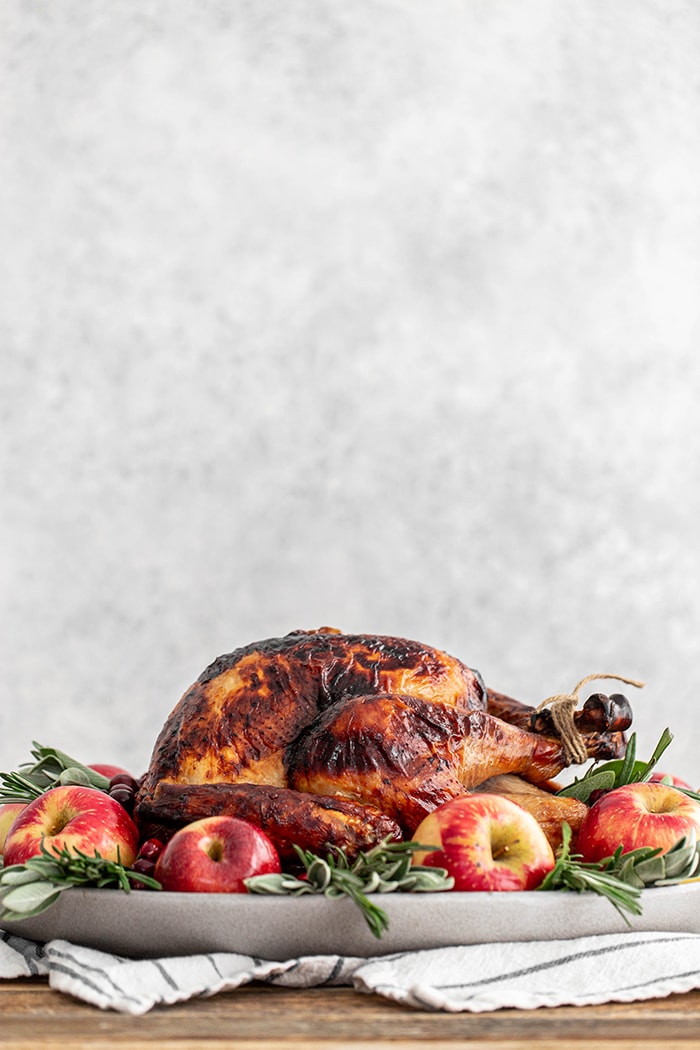
Click HERE to save this recipe for Apple Cider Sage Turkey Brine to Pinterest!
1. Preheat the oven to 375 degrees F. Slather the outside of the turkey in butter as well as under the breast skin.
2. Place herbs under the skin covering the breast, if desired.
3. Stuff the cavity with additional herbs, if desired, and an onion cut into sixths. Cover the wing tips with foil.
4. Use a V-Rack roaster for your turkey. Place 3 cups of water in the bottom of the pan. Add chopped onion and carrots at the bottom of the roasting pan.
5. Place the turkey on the rack, starting with it facing breast side down. Roast for 45 minutes.
6. Remove the turkey from the oven, flip it breast side up, and baste the turkey with pan drippings.
7. Cover the breast with foil.
8. Add an 2 more cups of water to the pan.
9. Roast the turkey for an additional 1 1/2 hours to 2 1/2 hours. The turkey is done when a meat thermometer inserted in the breast registers 160 degrees F, and the leg/thigh registers at about 170 degrees F.
10. When the turkey has reached the correct temperature, remove it from the oven and tent it with foil.
11. Let your turkey rest for 30-45 minutes on a large cutting board before carving. I know, the last thing you want to do after spending ALL DAY roasting a turkey is to wait even longer before slicing in to it.
Let the turkey rest for 20 – 30 minutes before slicing into it for the best results. The turkey will be easier to cut and the meat will stay juicer. It is worth the wait.
Oops! Did the Turkey finish roasting too early?
Place a disposable roasting tray inside a well insulated cooler. Then, place the finished turkey on the roasting tray. Close the cooler, and store until ready to serve (within about 2 hours). The cooler will act as a warming drawer for the turkey, and the juices will have plenty of time to redistribute while it rests.
Tips for Roasting a Whole Turkey
Don't Stuff Your Turkey
I don't recommend stuffing a turkey, because the stuffing may not reach a high enough temperature to kill bacteria. Plus, your turkey will cook faster without a stuffed cavity.
How to Safely Stuff a Turkey
- First, prepare and cook the stuffing separately while the turkey roasts.
- Then, place the stuffing into the turkey once it is done roasting.
If you really love stuffing inside your turkey, following the above method is the best way to ensure stuffing that is safe to eat.
An alternative is to stuff the turkey as is traditionally done by placing the stuffing in the cavity of the raw turkey. DO NOT pack it tightly so the air can circulate. You will need to take the temperature of the stuffing as well as the turkey meat. The stuffing also needs to reach 165 degrees F to be safe to eat. Probe Thermometers are great for checking temps! The problem with this method is that the meat can often reach higher temperatures and then turn out dry.
Cook by Temperature, Not by Time
There are a few things to know about roasting your turkey, and an important key to success is cooking by temperature.
Turkey roasting times vary depending on a variety of things, such as:
- the size of the bird
- internal temperature the bird when you begin
- your oven – ever oven runs slightly different (some hot, some cold, some exactly right)
So, it is better to have general time guidelines and specific temperature milestones to meet rather than cooking for x number of hours. You avoid overcooked dry meat and undercooked unsafe meat when you use a digital probe meat thermometer. Place the probe in the thickest part of the breast before you begin cooking.
More Thanksgiving Turkey Brine Recipes and Tips:
If you're looking for additional turkey brining inspiration for your Thanksgiving Menu this year, here are a few ideas. You'll find a lot more information about how to brine, along with a variety of recipes, in the below posts.
Fresh Herb Citrus Brined Turkey combines lots of fresh herbs with a subtle hint of citrus.
Brining a turkey in this Rosemary Beer Brine will tenderize the meat and infuse it with a TON of flavor for Turkey Day!
This recipe for Garlic Herb Peppercorn Dry Brine is really simple and produces juicy, seasoned turkey meat.
Turkey Smoked on a Traeger is one of my favorite ways to cook turkey for Thanksgiving. Come check out my tried and true method along with my 8 pro tips for the best smoked turkey!
And remember: once you've picked your Thanksgiving turkey clean, you can reuse the carcass to make Homemade Turkey Stock!
And be sure to check out the whole Thanksgiving Recipes Archive right here if you need help building the rest of your menu.
Have you ever brined a turkey before?
Love this Apple Cider Turkey Brine recipe? Sign up for Good Life Eats email updates and never miss another recipe!
Ingredients
- 3 quarts fresh apple cider*
- 1 1/4 cup Morton kosher salt
- 4 bay leaves
- 3 tablespoons whole allspice berries
- 2 tablespoons peppercorns
- packed 2/3 cup chopped fresh sage leaves
- peel of 2 large oranges
- 3 quarts cold water
Instructions
To Prepare the Brine:
- In a large stockpot, combine everything except the water.
- Bring to a rolling boil over medium-high heat. Turn heat off and cool to room temperature. Add cold water.
- For smaller stock pots, you may have to allow the brine to cool and add the additional amount when pouring the brine into the bag in the following step.
To Brine the Turkey:
- Place the turkey in a large zip-top bag. I recommend the Ziploc Big Bags (size large). Put the bagged turkey in a clean cooler.
- Pour the brine over the turkey, in the bag, making sure the breasts are fully submerged. Zip the bag closed.
- Place the cooler in a cool place, such as your garage or basement (if temperatures are cold enough), and allow the turkey to soak in the cold brine for 12-24 hours.
- Use gel ice packs or bagged ice around the zipped bag inside the cooler, if necessary, to keep the brine below 40°F. (Adding more ice directly to the brine would only dilute it.)
- Alternatively, if you have room in your refrigerator, you may place the bagged turkey in a large foil tray rather than a cooler and store it on the fridge shelf.
- Rinse the turkey inside and out and pat dry the turkey with paper towels.
- Bring to room temperature for 1-2 hours before roasting. Roast according to your preferred method.
Notes
Salt Injected Turkey
*The salt amount listed in this recipe is for a fresh, non-salt injected turkey and explained in the post. If you plan to use a salt injected turkey, then use 1 1/2-2 cups of Morton Kosher Salt. Rinse the bird inside and out before and after brining. Do not add any extra salt to season the bird and use unsalted butter if you plan to butter it.
Kosher Salt
Depending on the brand of kosher salt you use, you'll need different amounts of salt because the different brands available on the market have different densities. I use Morton's kosher salt in this recipe, however here are the conversions:
- Diamond Crystal 2 cups salt per gallon of liquid.
- Morton's kosher 1-1 1/4 cups salt per gallon of liquid.
Brining Time Guide
For a smaller turkey you may make less brine; however, be careful to do so with the original proportions of ingredient still intact.
Too much salt will leave you with an incredibly salty turkey.
Also, birds less than 10 pounds will likely not need to soak for the full 24 hours to achieve the desired results.
- Whole Turkey: 12-24 hours
- Turkey Breast: 3-6 hours
- Large Whole Chicken: 2-4 hours
Nutrition Information
Yield 12 Serving Size 1
Amount Per Serving Calories 98 Total Fat 1g Saturated Fat 0g Trans Fat 0g Unsaturated Fat 0g Cholesterol 0mg Carbohydrates 25g Fiber 5g Sugar 17g Protein 1g
GoodLifeEats.com offers recipe nutritional information as a courtesy and is an estimate only. This information comes from online calculators. Although GoodLifeEats.com makes every effort to provide accurate information, these figures are only estimates.
Be sure to follow Good Life Eats on Instagram. Tag @goodlifeeats and include the hashtag #goodlifeeatsrecipes so I can see what you're cooking up in YOUR kitchen!
Did you make this recipe for Apple Cider Turkey Brine? I'd love to hear what you thought! Leave me a comment below.
Source: https://www.goodlifeeats.com/apple-cider-sage-turkey-brine/
0 Response to "Easy Turkey Brine With Apple Cider Vinegar"
Post a Comment